Displaying and redisplaying Nimrud at the Iraq Museum
On this page, Dr Lamia al-Gailani discusses how Nimrud artefacts have been displayed in the Iraq Museum TT in Baghdad PGP over the past century. Dr al-Gailani has worked with the Iraq Museum for many decades and has recently been carrying out archival work on the Museum's history. Here she presents some historical photographs from the Museum's rich archival collections.
The first premises for the Baghdad Archaeological Museum were acquired in 1926, with the assistance of British archaeologist Gertrude Bell PGP . This former law training school in Al-Mamoun Street was intended to be a temporary home until a purpose-built space could be constructed, but the museum had to wait 40 years for this to be realised. A new museum building was constructed in the 1960s and still houses the Iraq Museum today (Image 1).
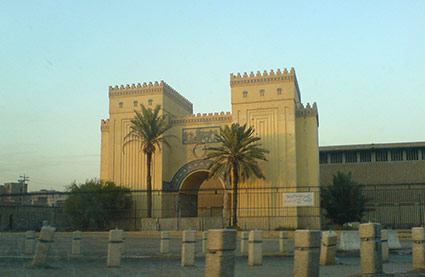
Image 1: Replica of an Assyrian city gate from the city of Khorsabad PGP , part of the Iraq Museum. The gate became part of the Children's Museum in 1982. The brick-filled hole in the gate's centre is repaired damage, caused by a shell during fighting in 2003 TT . Image: Public domain. View large image (707 KB).
There is an impressive amount of material in the Iraq Museum's archives that has been collected and accumulated over the decades. The following images are not intended to give a complete chronological history of the museum, but rather some snapshots, because I am working with what material I can find. A lot of things are still chaotic at the Museum and the archives are a hotchpotch at the moment. For example, there are very good microfilms TT for the Islamic manuscripts made the 1990s, although they now don't have a microfilm machine, so people can't see it. Some other parts of the archives haven't been worked on - a lot is still uncatalogued or only partially catalogued.
If the records were in date order, it would be easier to go through the material for the 1920s and 30s, but it's not organised according to date. There's now a very dedicated head of department, and people are working on it, but there are language issues when dealing with a lot of the early material. Most of the people who work with the archives only know Arabic, so it is very difficult to categorise documents in languages such as English or German. So the first step in my work is going through material and scanning, without much detailed reading. Later I hope I'll be able to sit and read in more detail.
The old museum
Most of the the objects from Nimrud at the Iraq Museum come from 1950s excavations or later, but a few arrived as early as the 1920s. We can see the way they were exhibited by looking at early photographs.

Image 2: King Faisal I PGP unveiling a bust of Gertrude Bell at the Iraq Museum. Colossal statues of guards from Nimrud tower over the assembled crowd. Image: Iraq Museum. View large image (669 KB).
The first objects from Nimrud that arrived at the Museum are two colossal statues of guards from Nabu's temple, which were found by Rassam PGP , I think, but were left at Nimrud. They were brought to the Museum at the end of 1926, transported by the Iraq Petroleum Company TT . It's a tradition that the oil company brings everything that is too heavy. This was after Gertrude Bell's time, but she must have worked to get them. The statues are pictured in the background of Image 2, which shows king Faisal I PGP unveiling a bust of Gertrude Bell at the museum. King Faisal is talking to the High Commissioner Sir Henry Dobbs PGP , and behind him is the Minister of Education, Abdul Hussein Chelebi PGP , who is the grandfather of a well-known politician today. The objects were not intended to be the main subject here, but are luckily captured on film due to their large size.

Image 3: The Shah of Iran, visiting the Museum when he was still crown prince. Walking next to him, past one of the winged bulls from Nimrud, is the Director-General of Antiquities TT , Sati' al-Husri PGP . Behind him is archaeologist Seton Lloyd PGP , then President of the British School of Archaeology in Iraq. Image: Iraq Museum. View large image (436 KB).
Nimrud objects also feature in Image 3, taken in the 1930s during a visit by the Shah of Iran when he was still crown prince TT . Here the visitors are walking past a winged bull TT from the Northwest Palace, so we can see that the bull was definitely in the museum by the 1930s. It is one of two winged bulls from Nimrud that were in the courtyard at the museum's entrance.
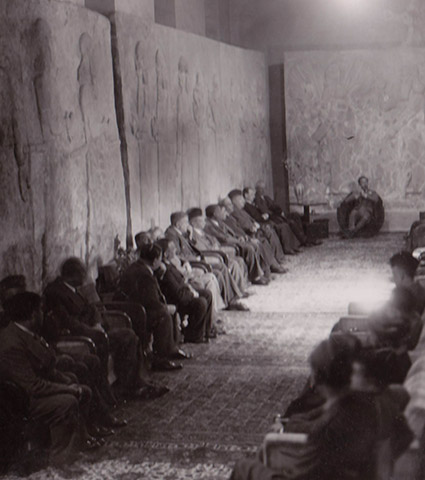
Image 4: A group of men sitting in one of the Iraq Museum's galleries, surrounded by stone bas-reliefs TT . Image: Iraq Museum. View full image (223 KB).
Image 4 shows a group of men sitting in the Assyrian room. It's difficult to know exactly what event is taking place here, but I think it was a medical conference. Incidental records like this show us how objects were exhibited, even though they are not purposely-taken photos of displays.
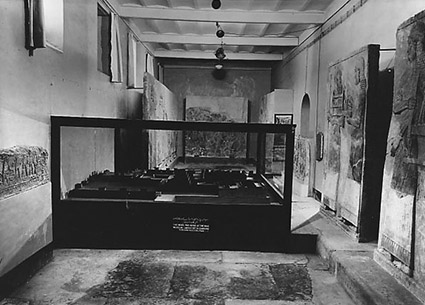
Image 5: The Assyrian room at the Iraq Museum. Image: Iraq Museum. View full image (77 KB).
Early displays contained a mixture of objects from Nimrud and from Khorsabad PGP . Image 5 shows the Assyrian room itself, mostly containing Khorsabad material. This is the earliest picture of it, with a model of the city in the centre.
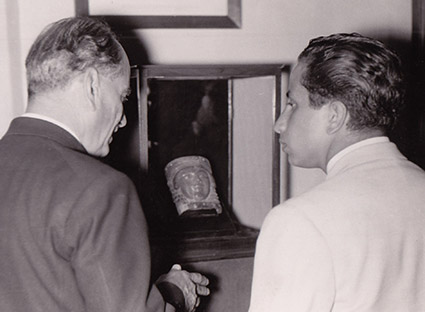
Image 6: Dr Naji al-Aseel PGP , Director-General of Antiquities, and king Faisal II PGP in front of the 'Mona Lisa of Nimrud', a finely carved ivory female head found along with other objects down a well in the Northwest Palace. Image: Iraq Museum. View full image (77 KB).
I looked for pictures for the smaller finds from Nimrud but couldn't find any. Unfortunately, I think people were not interested. Either they didn't have cameras at the time, or they didn't waste film on just photographing cases. A rare exception is the iconic object shown in Image 6. Here king Faisal II PGP is standing in front of a special case in the old museum building, containing a finely carved ivory TT female head. The head was discovered down a well in Room NN of the Northwest Palace. Dr Naji al-Aseel PGP , Director-General of Antiquities, nicknamed the piece the 'Mona Lisa of Nimrud' because of its fine craftsmanship. The 'Mona Lisa' became one of the site's most famous discoveries, appearing on the front page of the British periodical The Illustrated London News TT in August 1952 (1)(2).
The new museum

Image 7: A stone statue from Nabu's temple at Nimrud, outside the Iraq Museum. Image: Iraq Museum. View large image (304 KB).
When the new Iraq Museum building was finished in 1966, a stone statue of a guardian - one of two statues from the entrance of Nabu's shrine in his temple at Nimrud - was placed outside (Image 7). The plan for the new museum building was by a German architect called Werner March PGP and he tried to make it look like a traditional Iraqi house. I personally think he succeeded in doing that.
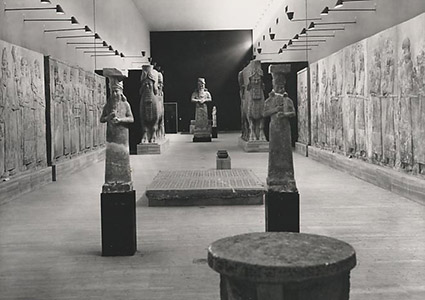
Image 8: Displays of material from Khorsabad and Nimrud at the Iraq Museum. Image: Iraq Museum. View large image (82 KB).
Image 8 is one of the early photographs in the new museum, after 1966, with the Nimrud material visible at the back. The throne base of Shalmaneser III PGP is partly visible at the far end of the room.
If you were to look at the winged bulls up close, you would see parallel incisions on them. This is damage that was done in the 1990s when the Ministry of Culture TT wanted to have a replica of these statues made to put inside the Ministry building. The incisions happened when they were making a mould of the object, and it's apparently been very difficult to remedy them.
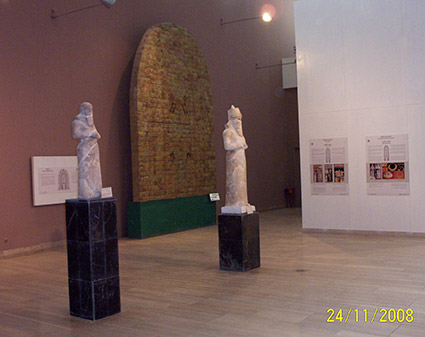
Image 9: Assyrian displays at the Iraq Museum in 2008. The 4-metre high panel of glazed bricks on the rear wall comes from king Shalmaneser III's palace at Nimrud, now known as Fort Shalmaneser (IM 72136). Image: Lamia Al-Gailani Werr. View large image (457 KB).
Image 9 shows what the galleries looked like in 2008. Nimrud material has been separated from the Khorsabad material and for the first time, they have produced information panels with text in both English and Arabic. The writing is rather small and you have to be very close to read it, but having panels is a big improvement.
This page is based on Dr al-Gailani's talk given at the Nimrud: Mound to Museum study day in April 2013.
Content last modified: 18 Dec 2019.
References
- Mallowan, M.E.L., 1966. Nimrud and Its Remains, vols. I-II, London: Collins, p. 260. (Find in text ^)
- The Illustrated London News, 16 August 1952, p. 1. (Find in text ^)
Lamia al-Gailani Werr
Lamia al-Gailani Werr, 'Displaying and redisplaying Nimrud at the Iraq Museum', Nimrud: Materialities of Assyrian Knowledge Production, The Nimrud Project at Oracc.org, 2019 [http://oracc.museum.upenn.edu/nimrud/modernnimrud/atthemuseum/iraqmuseumdisplays/]